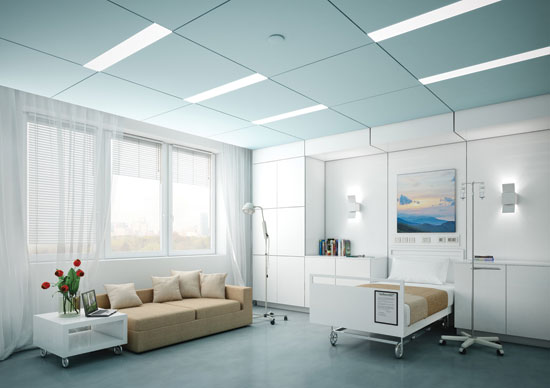Ceiling Technology and Aesthetics
New techniques for applying color and pattern have included geometric patterns and faux finishes that mimic leather, Venetian plasters, wood grain, and the like, as well as painted metals and thin wood veneers over a metal substrate. Some of these finishes are applied on site, often by skilled trades. Other finish solutions are factory applied, which reduces work on the jobsite and, in some cases, the amount of coatings and associated volatile organic compounds (VOCs) introduced in construction.
Two recent trends have contributed to interest in color and pattern in ceiling systems. One has been the movement toward therapeutic environments. Typically associated with healthcare facilities, these psycho-socially supportive spaces can benefit patient recovery and satisfaction as well as organizational productivity and outcomes, according to HOK senior associate Ron Smith, AIA, ACHA, and Nicholas Watkins, Ph.D., HOK's director of research and innovation. “The effects can be positive or negative,” they wrote in the Whole Building Design Guide. “No environment is neutral.”
 |
Therapeutic environments in healthcare buildings, schools and other facilities include the use of chromatherapy to positively affect the experience of occupants and visitors. Image courtesy of Hunter Douglas Contract |
The principle that colors may have medical value or healing benefits is known as color therapy or chromatherapy, according to PVA Architecture's Maryia A. Boykins, Assoc. AIA, who notes that the seven discrete primary colors of the visible spectrum “improve balance and healing in the mind and body.” In his seminal studies on the subject, Roger Ulrich, Ph.D., of Texas A&M University, has called color and pattern a “positive distraction” to explain this therapeutic effect.
While the effects of chromatherapy have been considered as part of evidence-based design (EBD) studies for healthcare environments, they are seen as useful for other building types, too. In a recent white paper on correctional facility design commissioned by Norix Group,1 the designer Tara Rae Hill, ASID, observed, “Leading research shows that interiors which have an interesting use of material and color and that are not overly neutral will increase morale and mental well-being, ultimately reducing inmate and staff anxieties.” Color selection also impacts spatial perception and the “visual weight” of interior surfaces, according to color experts at paint manufacturer Sherwin-Williams.2 For example, solids and simple patterns reduce visual weight while bold patterns add visual weight; for ceilings, light colors tend to attract attention, while dark-colored ceilings tend to direct the occupant's eye back to walls, furnishings and accessories in a room. Applied to the ceiling, red hues tend to be “weighty and annoying,” while orange can be “energizing.”









